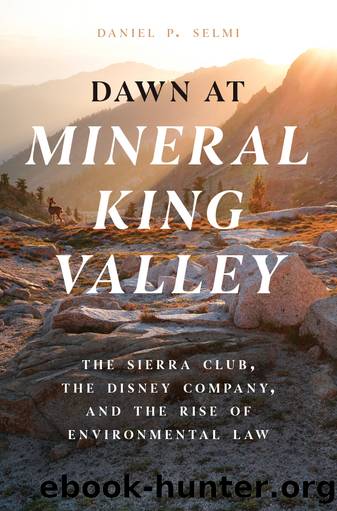Dawn at Mineral King Valley by Daniel P. Selmi;

Author:Daniel P. Selmi; [Selmi, Daniel P.]
Language: eng
Format: epub
Tags: NAT000000 NATURE / General, NAT011000 NATURE / Environmental Conservation & Protection, LAW034000 LAW / Environmental, LAW060000 LAW / Legal History, LAW000000 LAW / General
Publisher: University of Chicago Press
Published: 2022-07-07T00:00:00+00:00
Since the inception of the litigation, Lee Selna had firmly believed that requiring actual use of Mineral King to establish standing made no sense. He reiterated that viewpoint in the clubâs brief replying to the governmentâs opposition. A litigant âneed not, and therefore should not, resort to artifice by alleging injury to an inconsequential but unique material interest when injury to the litigantâs aesthetic, conservational or recreational interest is the real reason for the lawsuit.â While the Sierra Club had sponsored pack trips originating in Mineral King, that activity âis of such little importance to the Club that it would not incur all of the disadvantages of litigation in an attempt to protect it.â69 The adversity required of a party to establish standing did not arise here from an interference with pack trips, but from the clubâs interest in Mineral King and Sequoia National Park which the Disney plan threatened.
Finally, the Sierra Club reply brief charged that, in suggesting that use of Mineral King might support standing, the government had an ulterior motive. The Sierra Club had won a preliminary injunction in the district court, and one legal consideration in the granting of such injunctions is the effect on the âpublic interest.â By championing âuseâ as the test for standing, Selna reasoned, the government sought to establish a decisive advantage in opposing claims for injunctions. Under its position, the government won either wayâit was a âheads I win, tails you loseâ proposition. â[E]ither the courthouse door is barred for lack of assertion of a private, unique injury or a preliminary injunction is denied on the ground that the litigant has advanced private injury which does not warrant an injunction adverse to a competing public interest.â The Sierra Clubâs lawyers âshaped their case to avoid this trap.â70
In the end, though, Selna seemed to hedge his bets just slightly. His brief told the court: âWhile not emphasized in the record, there is no dispute that the Club represents the interest of its members who actually physically use and enjoy Mineral King and Sequoia National Park in their present state.â71 An accompanying footnote added that this âuse and enjoyment is graphically detailedâ in a letter, included in the case record, in which Mike McCloskey had requested the Forest Service to hold a hearing on the proposal to develop Mineral King.
Download
This site does not store any files on its server. We only index and link to content provided by other sites. Please contact the content providers to delete copyright contents if any and email us, we'll remove relevant links or contents immediately.
Second Nature (The Shape-Shifter Series #1) by Jae(1054)
Petroleum Contracts by Peter Roberts(868)
The Global Commons by Susan J. Buck(865)
Infrastructure by Frischmann Brett M(811)
The Monk by Matthew Lewis(791)
Japan Travel Guide: Things I Wish I Knew Before Going To Japan (2019 EDITION) by Fukuyama Ken & Fukuyama Yuki(777)
Ever After by William Wharton(746)
Before Earth Day by Karl Boyd Brooks(716)
Good for You, Great for Me by Lawrence Susskind(709)
War of the Whales by Joshua Horwitz(686)
Biting the Hands that Feed Us by Baylen J. Linnekin(679)
Respecting Animals by David S. Favre(655)
Animal Law in a Nutshell by Frasch Pamela & Hessler Katherine & Waisman Sonia(654)
Uncommon Ground by William Cronon(653)
Rangeland Systems by David D. Briske(643)
After Nature: A Politics for the Anthropocene by Jedediah Purdy(641)
The Ethics of Space Exploration by James S.J. Schwartz & Tony Milligan(633)
Fracking the Neighborhood by Jessica Smartt Gullion(608)
Down to the Wire: Confronting Climate Collapse by David W. Orr(601)
